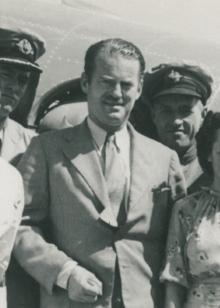James Fairbairn | |
|---|---|
 | |
| Minister for Air and Civil Aviation | |
| In office 26 April 1939 – 13 August 1940 | |
| Prime Minister | Robert Menzies |
| Preceded by | Harold Thorby (Civil Aviation) |
| Succeeded by | Arthur Fadden |
| Member of the Australian Parliament for Flinders | |
| In office 11 November 1933 – 13 August 1940 | |
| Preceded by | Stanley Bruce |
| Succeeded by | Rupert Ryan |
| Member of the Victorian Parliament for Warrnambool | |
| In office May 1932 – October 1933 | |
| Preceded by | Henry Bailey |
| Succeeded by | Keith McGarvie |
| Personal details | |
| Born | 28 July 1897 Wadhurst, Sussex, England |
| Died | 13 August 1940 (aged 43) Canberra, Australian Capital Territory, Australia |
| Nationality | Australian |
| Political party | UAP |
| Spouse |
Daisy Olive Forrester
(m. 1923) |
| Relations | George Fairbairn (uncle) Steve Fairbairn (uncle) |
| Occupation | Grazier |
James Valentine Fairbairn (28 July 1897 – 13 August 1940) was an Australian aviator and politician. A World War I fighter pilot, he represented the United Australia Party (UAP) in federal parliament and served as Minister for Air and Civil Aviation from 1939 until his death the following year.
Fairbairn was born in England to Australian parents, and grew up in country Victoria. At the age of 18 he returned to England to enlist in the Royal Flying Corps (RFC). He was shot down behind enemy lines on one of his first missions and received a severe arm injury, subsequently spending over a year as a German prisoner-of-war. Fairbairn subsequently became a grazier in Victoria's Western District. He briefly served in the Victorian Legislative Assembly (1932–1933) before winning a by-election to the House of Representatives. Fairbairn continued flying as a civilian and was recognised as an aviation expert. He was appointed to cabinet in 1939 as a member of the first Menzies Government. He was killed in the 1940 Canberra air disaster along with two of his cabinet colleagues and the head of the army.